 The Game: Helicopters and planes are dumping paratroopers directly over your land-locked cannon. Your job is to take out both aircraft and paratroopers before the enemy can land on and slowly destroy the rows of buildings on either side of the cannon. Once enemy paratroopers raze a building to the ground, they begin doing something even deadlier: digging tunnels toward your cannon so they can destroy it from below with a giant bomb, at which time your point defense career is over. (U.S. Games, 1982)
The Game: Helicopters and planes are dumping paratroopers directly over your land-locked cannon. Your job is to take out both aircraft and paratroopers before the enemy can land on and slowly destroy the rows of buildings on either side of the cannon. Once enemy paratroopers raze a building to the ground, they begin doing something even deadlier: digging tunnels toward your cannon so they can destroy it from below with a giant bomb, at which time your point defense career is over. (U.S. Games, 1982)
Memories: A clever riff on a well-known game, Commando Raid avoids being just another Missile Command clone. At first glance, the element of defending six cities/buildings by covering the entire sky from a fixed position seems familiar, but the gradual enemy occupation of territory beneath the player’s cannon adds an original twist and requires some new strategy.
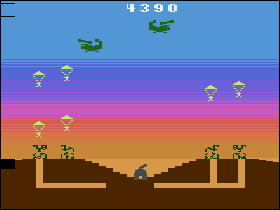 U.S. Games didn’t exactly make stuff that looked like Activision‘s games, but the audiovisual element of Commando Raid is more than adequate to convey all the information players need. The buildings have several stages of disrepair, from undamaged down to rubble. The sheer twitch factor as multiple incoming targets have to be dealt with is impressive for a VCS cartridge, as is the fact that the barrage of approaching enemies is accomplished with virtually none of the dreaded “flicker” that has plagued countless other games on this platform.
U.S. Games didn’t exactly make stuff that looked like Activision‘s games, but the audiovisual element of Commando Raid is more than adequate to convey all the information players need. The buildings have several stages of disrepair, from undamaged down to rubble. The sheer twitch factor as multiple incoming targets have to be dealt with is impressive for a VCS cartridge, as is the fact that the barrage of approaching enemies is accomplished with virtually none of the dreaded “flicker” that has plagued countless other games on this platform.
 Seasoned Missile Commanders looking for a new posting can do a lot worse than signing up to go Commando.
Seasoned Missile Commanders looking for a new posting can do a lot worse than signing up to go Commando.
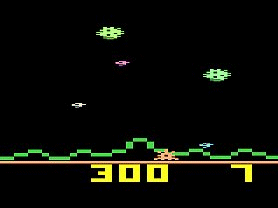 The Game: Your planet is under siege by an unending hail of asteroids, bombs, and space debris. Your simple mission? Blast all of this stuff, or dodge it. But you’re toast if a bomb hits the ground. (M Network [Mattel], 1982)
The Game: Your planet is under siege by an unending hail of asteroids, bombs, and space debris. Your simple mission? Blast all of this stuff, or dodge it. But you’re toast if a bomb hits the ground. (M Network [Mattel], 1982)
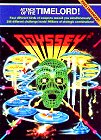 The Game: The game begins as the skull-like face of Spyruss the Deathless (the Timelord of Chaos, no less!) taunts you (well, only if you had the Voice), and then a bunch of pesky spaceships pops out of a vortex to shoot at you. They shoot at you rather a lot. Fortunately, you can shoot back with reckless abandon, but their ammunition – as you ascend into the higher levels of the game – can track you and even, if you don’t destroy their shots in mid-air, crawl along the ground briefly while you head for the opposite side of the screen, neatly trapped for their next volley. (North American Philips, 1982)
The Game: The game begins as the skull-like face of Spyruss the Deathless (the Timelord of Chaos, no less!) taunts you (well, only if you had the Voice), and then a bunch of pesky spaceships pops out of a vortex to shoot at you. They shoot at you rather a lot. Fortunately, you can shoot back with reckless abandon, but their ammunition – as you ascend into the higher levels of the game – can track you and even, if you don’t destroy their shots in mid-air, crawl along the ground briefly while you head for the opposite side of the screen, neatly trapped for their next volley. (North American Philips, 1982)

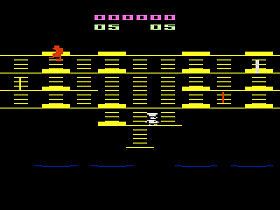 The Game: As Chef Peter Pepper, you climb around a multi-level factory whose sole function is to make some really big burgers. We’re talking about some BIG burgers here. But your ingredients aren’t exactly cooperating with you… (M Network [Mattel, under license from Data East], 1982)
The Game: As Chef Peter Pepper, you climb around a multi-level factory whose sole function is to make some really big burgers. We’re talking about some BIG burgers here. But your ingredients aren’t exactly cooperating with you… (M Network [Mattel, under license from Data East], 1982)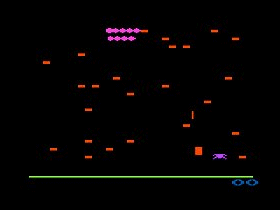 The Game: Centipedes, spiders and fleas invade your garden of ‘shrooms. Spiders follow an evasive course and can collide with you at any moment. Fleas poison the mushrooms, making them impervious to your fire (and thus giving the
The Game: Centipedes, spiders and fleas invade your garden of ‘shrooms. Spiders follow an evasive course and can collide with you at any moment. Fleas poison the mushrooms, making them impervious to your fire (and thus giving the 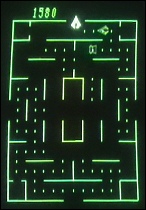 The Game: Years before Robovac and Roomba, there was Clean Sweep, a vacuum cleaner patrolling the vaults of a bank and picking up stray bits of money. (Makes you wonder who programmed it, and who’s emptying the bag!) As you grab more wayward currency, your bag fills up; when you hear an alarm sound, you have to go to the center of the maze to empty your bag and start anew; until you do that, you can’t pick up any more dead presidents. But those aren’t the only alarm bells going off here: things that look alarmingly like huge forceps are chasing you around. If they grab you, it’s your money and your life. There are four corners in the vault that will power up your vacuum cleaner temporarily, enabling you to suck up those forceps and (for a brief while) grab all the cash in your path without filling your bag. Clearing the maze advances you to the next level; losing all your lives leaves the bank wide open. (GCE, 1982)
The Game: Years before Robovac and Roomba, there was Clean Sweep, a vacuum cleaner patrolling the vaults of a bank and picking up stray bits of money. (Makes you wonder who programmed it, and who’s emptying the bag!) As you grab more wayward currency, your bag fills up; when you hear an alarm sound, you have to go to the center of the maze to empty your bag and start anew; until you do that, you can’t pick up any more dead presidents. But those aren’t the only alarm bells going off here: things that look alarmingly like huge forceps are chasing you around. If they grab you, it’s your money and your life. There are four corners in the vault that will power up your vacuum cleaner temporarily, enabling you to suck up those forceps and (for a brief while) grab all the cash in your path without filling your bag. Clearing the maze advances you to the next level; losing all your lives leaves the bank wide open. (GCE, 1982) The Game: Helicopters and planes are dumping paratroopers directly over your land-locked cannon. Your job is to take out both aircraft and paratroopers before the enemy can land on and slowly destroy the rows of buildings on either side of the cannon. Once enemy paratroopers raze a building to the ground, they begin doing something even deadlier: digging tunnels toward your cannon so they can destroy it from below with a giant bomb, at which time your point defense career is over. (U.S. Games, 1982)
The Game: Helicopters and planes are dumping paratroopers directly over your land-locked cannon. Your job is to take out both aircraft and paratroopers before the enemy can land on and slowly destroy the rows of buildings on either side of the cannon. Once enemy paratroopers raze a building to the ground, they begin doing something even deadlier: digging tunnels toward your cannon so they can destroy it from below with a giant bomb, at which time your point defense career is over. (U.S. Games, 1982)
 Seasoned Missile Commanders looking for a new posting can do a lot worse than signing up to go Commando.
Seasoned Missile Commanders looking for a new posting can do a lot worse than signing up to go Commando.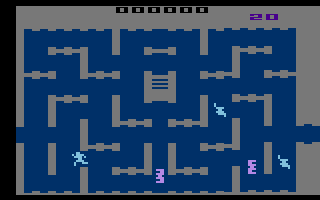 The Game: Robots, spiders and critters, oh my! You’re a lone human in a maze teeming with deadly robots, spiders and other nasties, and your trusty gun – which can dispatch any or all of the above – has only a limited amount of ammunition. You can obtain more ammo by walking over a briefly-occurring flashing gun symbol – but until then, if you’re out of ammo, you’re no longer the hunter, but the hunted. (M Network [Mattel], 1982)
The Game: Robots, spiders and critters, oh my! You’re a lone human in a maze teeming with deadly robots, spiders and other nasties, and your trusty gun – which can dispatch any or all of the above – has only a limited amount of ammunition. You can obtain more ammo by walking over a briefly-occurring flashing gun symbol – but until then, if you’re out of ammo, you’re no longer the hunter, but the hunted. (M Network [Mattel], 1982) The Game: In a very faithful adaptation of Nintendo’s all-time classic arcade game, you’re Mario, a rotund and lovesick fellow who would gladly scale scaffolding, bound over barrels and feint past foxfires, all to save the damsel in distress. (Coleco, 1982)
The Game: In a very faithful adaptation of Nintendo’s all-time classic arcade game, you’re Mario, a rotund and lovesick fellow who would gladly scale scaffolding, bound over barrels and feint past foxfires, all to save the damsel in distress. (Coleco, 1982)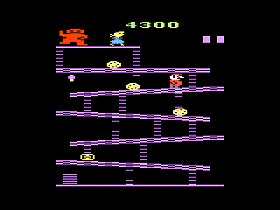 The Game: In the rotund plumber Mario’s first adventure, you have to help him reach the top of a perilous scaffolding to rescue a damsel in distress from the dastardly Donkey Kong. (Coleco, 1982)
The Game: In the rotund plumber Mario’s first adventure, you have to help him reach the top of a perilous scaffolding to rescue a damsel in distress from the dastardly Donkey Kong. (Coleco, 1982)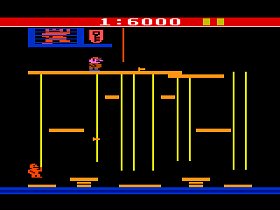 The Game: As little Donkey Kong Jr., you’re trying to reach the top of a treacherous series of vines and platforms to rescue your dad from Mario. (Coleco, 1982)
The Game: As little Donkey Kong Jr., you’re trying to reach the top of a treacherous series of vines and platforms to rescue your dad from Mario. (Coleco, 1982)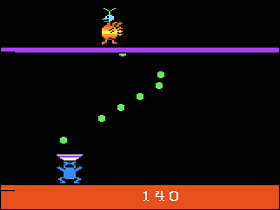 The Game: Which came first: your imminent defeat or the egg? A crazed chicken scoots back and forth across the top of the screen, hurling eggs downward at your suspiciously Cookie Monster-esque protagonist. Once your monster has captured all of the eggs (missing even one egg results in a lost “life”), you can fire the eggs back at the chicken and try to score a direct hit. (U.S. Games, 1982)
The Game: Which came first: your imminent defeat or the egg? A crazed chicken scoots back and forth across the top of the screen, hurling eggs downward at your suspiciously Cookie Monster-esque protagonist. Once your monster has captured all of the eggs (missing even one egg results in a lost “life”), you can fire the eggs back at the chicken and try to score a direct hit. (U.S. Games, 1982)
 The Game: In one of the most seminal variations on the Space Invaders format, Galaxian was among the first clones to introduce attacking formations that would break off from the usual rows and columns of invaders. Though Galaxian‘s use of this innovation was minimal, it was a drastic change from the usual slowly-advancing target gallery. (Atari, 1982)
The Game: In one of the most seminal variations on the Space Invaders format, Galaxian was among the first clones to introduce attacking formations that would break off from the usual rows and columns of invaders. Though Galaxian‘s use of this innovation was minimal, it was a drastic change from the usual slowly-advancing target gallery. (Atari, 1982)
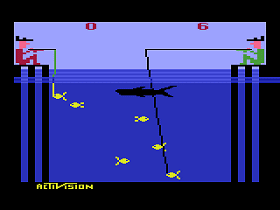 The Game: You (and a friend, in the two-player game) are sitting on the dock of the bay, watching the time float away, and trying to catch some dinner at the same time. There’s only one problem: apparently Roy Scheider led you to this fishin’
The Game: You (and a friend, in the two-player game) are sitting on the dock of the bay, watching the time float away, and trying to catch some dinner at the same time. There’s only one problem: apparently Roy Scheider led you to this fishin’  The Game: Using the left joystick, you control the movement of your ship within the confines of a screen filled with mines, alien aggressors, and occasional purple “confinement crystals” which you have to catch, because these contain human prisoners of war. The right joystick engages your hyperdrive, enabling you to go zipping along in true Defender style. (North American Philips, 1982)
The Game: Using the left joystick, you control the movement of your ship within the confines of a screen filled with mines, alien aggressors, and occasional purple “confinement crystals” which you have to catch, because these contain human prisoners of war. The right joystick engages your hyperdrive, enabling you to go zipping along in true Defender style. (North American Philips, 1982)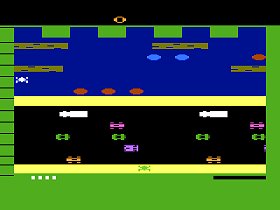 The Game: As in the arcade game of the same name, you try to help an amiable amphibian amble his way through rush hour traffic and a river full of dangers in a quest to get home. (Parker Brothers, 1982)
The Game: As in the arcade game of the same name, you try to help an amiable amphibian amble his way through rush hour traffic and a river full of dangers in a quest to get home. (Parker Brothers, 1982)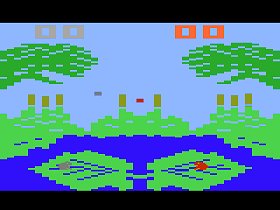 The Game: As one of two lowly bullfrogs, your task is simple: try to nab the greatest number of insect morsels possible on your froggy tongue while hopping around the lily pad. Hey, not every frog can live the wild life of Frogger, can they? (M Network [Mattel], 1982)
The Game: As one of two lowly bullfrogs, your task is simple: try to nab the greatest number of insect morsels possible on your froggy tongue while hopping around the lily pad. Hey, not every frog can live the wild life of Frogger, can they? (M Network [Mattel], 1982) eating flies” sub-genre being Atari’s own Frog Pond). Frogs & Flies is basically an Atari 2600 port of Mattel’s Frog Bog cartridge for their own Intellivision platform, a game which in turn “borrowed” its concept from Gremlin’s 1978
eating flies” sub-genre being Atari’s own Frog Pond). Frogs & Flies is basically an Atari 2600 port of Mattel’s Frog Bog cartridge for their own Intellivision platform, a game which in turn “borrowed” its concept from Gremlin’s 1978 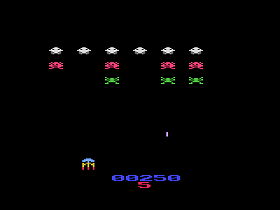 The Game: The Gorfian Empire is attacking Earth, and naturally you’re our only hope. Symmetrical waves of space invaders lead off the invasion, followed by more unpredictable laser attack waves with long-range weapons. Next, you must pick off Gorfian robots as they emerge from a space warp, and finally you take the fight directly to the Gorfian flagship, trying to get one perfect shot in at its most vulnerable point. (CBS Video Games, 1982)
The Game: The Gorfian Empire is attacking Earth, and naturally you’re our only hope. Symmetrical waves of space invaders lead off the invasion, followed by more unpredictable laser attack waves with long-range weapons. Next, you must pick off Gorfian robots as they emerge from a space warp, and finally you take the fight directly to the Gorfian flagship, trying to get one perfect shot in at its most vulnerable point. (CBS Video Games, 1982) 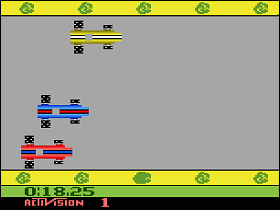
 The Game: Ever had a sweet tooth? Now you are the sweet tooth – or teeth, as the case may be. You guide a set of clattering teeth around a mazelike screen of horizontal rows; an opening in each row travels down the wall separating it from the next row. Your job is to eat the tasty treats lining each row until you’ve cleared the screen. Naturally, it’s not just going to be that easy. There are nasty hard candies out to stop you, and they’ll silence those teeth of yours if they catch you – and that just bites. Periodically, a treat appears in the middle of the screen allowing you to turn the tables on them for a brief interval. (Tigervision, 1982)
The Game: Ever had a sweet tooth? Now you are the sweet tooth – or teeth, as the case may be. You guide a set of clattering teeth around a mazelike screen of horizontal rows; an opening in each row travels down the wall separating it from the next row. Your job is to eat the tasty treats lining each row until you’ve cleared the screen. Naturally, it’s not just going to be that easy. There are nasty hard candies out to stop you, and they’ll silence those teeth of yours if they catch you – and that just bites. Periodically, a treat appears in the middle of the screen allowing you to turn the tables on them for a brief interval. (Tigervision, 1982) The Game: The player controls a marker, trying to claim as much of the playing field as possible by enclosing areas of it. Drawing boundaries faster is safer, but yields fewer points. A slower draw, which leaves the marker vulnerable to attack from the Jin and from the enemies in hot pursuit of the marker’s every move, is worth many more points upon the completion of an enclosed area. If the ever-shifting Jin touches the marker or an uncompleted boundary it is drawing, a “life” is lost and the game starts again. (Falcon, 1982)
The Game: The player controls a marker, trying to claim as much of the playing field as possible by enclosing areas of it. Drawing boundaries faster is safer, but yields fewer points. A slower draw, which leaves the marker vulnerable to attack from the Jin and from the enemies in hot pursuit of the marker’s every move, is worth many more points upon the completion of an enclosed area. If the ever-shifting Jin touches the marker or an uncompleted boundary it is drawing, a “life” is lost and the game starts again. (Falcon, 1982) The Game: Players control a segmented, centipede-like creature as it wanders through an open maze inhabited by similar creatures. The player’s creature can shoot segments off of the opponent creatures, but the opponents can also turn around and eat their own segments to get out of a corner, which won’t score any points for the player. To clear a level, the player must eliminate the other creatures from the maze. (Emerson [under license from Konami], 1982)
The Game: Players control a segmented, centipede-like creature as it wanders through an open maze inhabited by similar creatures. The player’s creature can shoot segments off of the opponent creatures, but the opponents can also turn around and eat their own segments to get out of a corner, which won’t score any points for the player. To clear a level, the player must eliminate the other creatures from the maze. (Emerson [under license from Konami], 1982)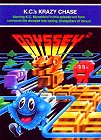 The Game: As a small blue spherical creature whose sole sensory organs consist of two eyes, two antennae and an enormous mouth, your mission – should you choose to accept it – is to start munching on the segmented body of the dreaded Dratapillar while avoiding its always-lethal head. When you consume one of its body segments, the Dratapillar’s two henchbeings – known only as Drats – turn white with fright and you can send them a-spinning (normally, they’re deadly to touch too). Eating all of the Dratapillar segments gets you to the next level, and the mayhem begins anew. (North American Philips, 1982)
The Game: As a small blue spherical creature whose sole sensory organs consist of two eyes, two antennae and an enormous mouth, your mission – should you choose to accept it – is to start munching on the segmented body of the dreaded Dratapillar while avoiding its always-lethal head. When you consume one of its body segments, the Dratapillar’s two henchbeings – known only as Drats – turn white with fright and you can send them a-spinning (normally, they’re deadly to touch too). Eating all of the Dratapillar segments gets you to the next level, and the mayhem begins anew. (North American Philips, 1982)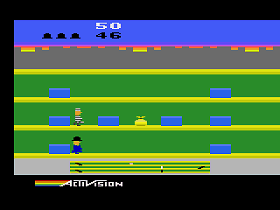
 The Game: In a stick-figure firefighter’s greatest adventure, you have to help him reach the top of a perilous scaffolding to rescue a damsel in distress from the dastardly Kong Kong. (Tiger Electronic Toys, 1982)
The Game: In a stick-figure firefighter’s greatest adventure, you have to help him reach the top of a perilous scaffolding to rescue a damsel in distress from the dastardly Kong Kong. (Tiger Electronic Toys, 1982) The Game: You’re a hungry ladybug in a maze full of dangers and morsels. Other insects roam the maze trying to eat you, and skulls scattered around the maze are also deadly to the touch. The only advantage you really have is to maneuver skillfully through the revolving doors, slamming them shut behind you and forcing your pursuers to take a different route (they can’t go through the revolving doors). (Coleco, 1982)
The Game: You’re a hungry ladybug in a maze full of dangers and morsels. Other insects roam the maze trying to eat you, and skulls scattered around the maze are also deadly to the touch. The only advantage you really have is to maneuver skillfully through the revolving doors, slamming them shut behind you and forcing your pursuers to take a different route (they can’t go through the revolving doors). (Coleco, 1982)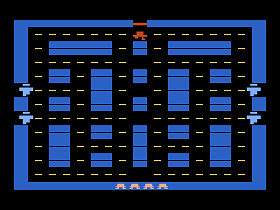 The Game: You’re in charge of a getaway car loaded with crafty criminals. Your job is to sneak around the maze, avoid four colorful cops who are hot on your trail, and grab all the dough – and, of course, to escape so you can steal again another day. But the cops can trap you with a series of doors that can prevent you from getting away… (M Network [Mattel Electronics], 1982)
The Game: You’re in charge of a getaway car loaded with crafty criminals. Your job is to sneak around the maze, avoid four colorful cops who are hot on your trail, and grab all the dough – and, of course, to escape so you can steal again another day. But the cops can trap you with a series of doors that can prevent you from getting away… (M Network [Mattel Electronics], 1982)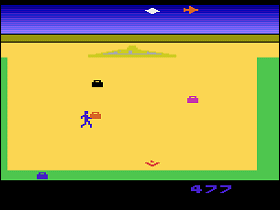 The Game: Before the TSA, there was… a little pixellated stick man on your Atari. Using the joysticks, your job is to direct this hapless less line of airport defense to catch every piece of luggage before it hits the sides or bottom of the screen. Failure to do so will result in the contents of the luggage spilling out across the floor; on some difficulty settings, black suitcases appear containing explosives that’ll detonate if that case isn’t caught. As soon as the area is successfully cleared of luggage, there’s a moment to catch your breath before the next plane lands and the process begins again. (Games By Apollo, 1982)
The Game: Before the TSA, there was… a little pixellated stick man on your Atari. Using the joysticks, your job is to direct this hapless less line of airport defense to catch every piece of luggage before it hits the sides or bottom of the screen. Failure to do so will result in the contents of the luggage spilling out across the floor; on some difficulty settings, black suitcases appear containing explosives that’ll detonate if that case isn’t caught. As soon as the area is successfully cleared of luggage, there’s a moment to catch your breath before the next plane lands and the process begins again. (Games By Apollo, 1982) The Game: An alien ship zooms into view overhead, depositing a network of mines in deep space. Your job is to clear the spaceways, blasting each mine and then blasting the smaller mines that are released by each subsequent explosion; there are three different mine sizes, and blasting the smallest and fastest ones finally does away with them. In later stages, there are homing mines, mines that launch a missile in your direction when detonated, and other hazards. Smaller alien ships periodically zip through the screen, trying to blast you while also laying fresh mines. (GCE, 1982)
The Game: An alien ship zooms into view overhead, depositing a network of mines in deep space. Your job is to clear the spaceways, blasting each mine and then blasting the smaller mines that are released by each subsequent explosion; there are three different mine sizes, and blasting the smallest and fastest ones finally does away with them. In later stages, there are homing mines, mines that launch a missile in your direction when detonated, and other hazards. Smaller alien ships periodically zip through the screen, trying to blast you while also laying fresh mines. (GCE, 1982)